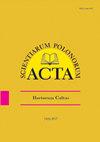在不同 LED 光质条件下建立网纹草 "Vertigo®"的离体培养基并繁殖其嫩枝
IF 0.7
4区 农林科学
Q4 HORTICULTURE
引用次数: 0
摘要
本研究提供了一种在不同 LED 光照条件下进行观赏草 Pennisetum 'Vertigo®' 离体培养和芽繁殖的方法。培养是从 10 月 1 日至 10 月 30 日每周采集的田间栽培植物开始的。采集嫩枝尖的日期越晚,表面消毒的效果越好(从第一个日期的 46%提高到第五个日期的 93%),再生外植体的百分比也越高(从第一个日期的 34%提高到第五个日期的 93%)。顶芽的消毒和再生效果优于腋芽。在表面消毒前将外植体浸泡在硝酸菌素中,或使用含有抗生素的培养基,都能提高消毒效果(甚至提高 27-46%,视组合而定),而且不会抑制外植体的再生。在嫩枝繁殖阶段,顶芽发出的嫩枝的繁殖率(5.5 个/外植体)是腋芽发出的嫩枝的两倍。在红蓝光(RBY)光谱中加入黄光可提高繁殖率,在红蓝光(RBG)光谱中加入绿光可增加芽的鲜重。在红蓝光以及 RBY 和 RBG 光下繁殖的嫩芽叶绿素 a 含量最高。本文章由计算机程序翻译,如有差异,请以英文原文为准。
Establishing in vitro cultures of Pennisetum ‘Vertigo®’ and its shoot multiplication under different LED light quality
This study provides a method for ornamental grass Pennisetum ‘Vertigo®’ in vitro culture initiation and shoot multiplication under different LED light qualities. The culture was initiated from field-cultivated plants collected from the 1st to 30th October at weekly intervals. Later dates of collecting shoot tips increased the effectiveness of surface disinfection (from 46% on the first date to 93% on the fifth one) and the percentage of regenerating explants (from 34% on the first date to 93% on the fifth one). Disinfection and regeneration results were better for the apical buds than the axillary buds. Soaking explants in nystatin before surface disinfection or using a medium with an antibiotic increased the effectiveness of disinfection (even by 27–46%, depending on the combination) and did not inhibit the regeneration of explants. At the shoot propagation stage, the multiplication rate was twice as high for the shoots originating from the apical buds (5.5 per explant) than for those originating from the axillary buds. The addition of yellow light to the red and blue light (RBY) spectrum increased the multiplication rate, and the addition of green light to the red and blue (RBG) spectrum increased the fresh weight of the shoots. The highest content of chlorophyll a was found in the shoots propagated under RB, as well as RBY and RBG light.
求助全文
通过发布文献求助,成功后即可免费获取论文全文。
去求助
来源期刊
CiteScore
1.30
自引率
14.30%
发文量
61
审稿时长
4-8 weeks
期刊介绍:
In Acta Scientiarum Polonorum Hortorum Cultus we publish original research papers and review articles containing new and significant information on broad aspects of horticulture and related disciplines. The papers are published in English only, in six issues yearly.

 求助内容:
求助内容: 应助结果提醒方式:
应助结果提醒方式:


